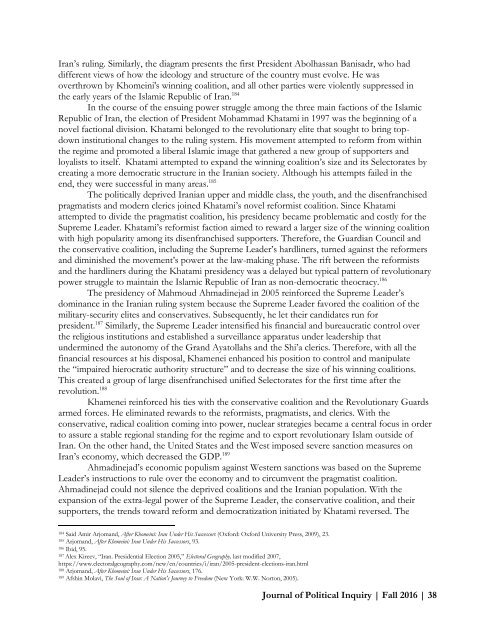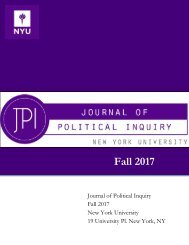Fall2016_Final
Create successful ePaper yourself
Turn your PDF publications into a flip-book with our unique Google optimized e-Paper software.
Iran’s ruling. Similarly, the diagram presents the first President Abolhassan Banisadr, who had<br />
different views of how the ideology and structure of the country must evolve. He was<br />
overthrown by Khomeini's winning coalition, and all other parties were violently suppressed in<br />
the early years of the Islamic Republic of Iran. 184<br />
In the course of the ensuing power struggle among the three main factions of the Islamic<br />
Republic of Iran, the election of President Mohammad Khatami in 1997 was the beginning of a<br />
novel factional division. Khatami belonged to the revolutionary elite that sought to bring topdown<br />
institutional changes to the ruling system. His movement attempted to reform from within<br />
the regime and promoted a liberal Islamic image that gathered a new group of supporters and<br />
loyalists to itself. Khatami attempted to expand the winning coalition’s size and its Selectorates by<br />
creating a more democratic structure in the Iranian society. Although his attempts failed in the<br />
end, they were successful in many areas. 185<br />
The politically deprived Iranian upper and middle class, the youth, and the disenfranchised<br />
pragmatists and modern clerics joined Khatami’s novel reformist coalition. Since Khatami<br />
attempted to divide the pragmatist coalition, his presidency became problematic and costly for the<br />
Supreme Leader. Khatami’s reformist faction aimed to reward a larger size of the winning coalition<br />
with high popularity among its disenfranchised supporters. Therefore, the Guardian Council and<br />
the conservative coalition, including the Supreme Leader’s hardliners, turned against the reformers<br />
and diminished the movement’s power at the law-making phase. The rift between the reformists<br />
and the hardliners during the Khatami presidency was a delayed but typical pattern of revolutionary<br />
power struggle to maintain the Islamic Republic of Iran as non-democratic theocracy. 186<br />
The presidency of Mahmoud Ahmadinejad in 2005 reinforced the Supreme Leader’s<br />
dominance in the Iranian ruling system because the Supreme Leader favored the coalition of the<br />
military-security elites and conservatives. Subsequently, he let their candidates run for<br />
president. 187 Similarly, the Supreme Leader intensified his financial and bureaucratic control over<br />
the religious institutions and established a surveillance apparatus under leadership that<br />
undermined the autonomy of the Grand Ayatollahs and the Shi’a clerics. Therefore, with all the<br />
financial resources at his disposal, Khamenei enhanced his position to control and manipulate<br />
the “impaired hierocratic authority structure” and to decrease the size of his winning coalitions.<br />
This created a group of large disenfranchised unified Selectorates for the first time after the<br />
revolution. 188<br />
Khamenei reinforced his ties with the conservative coalition and the Revolutionary Guards<br />
armed forces. He eliminated rewards to the reformists, pragmatists, and clerics. With the<br />
conservative, radical coalition coming into power, nuclear strategies became a central focus in order<br />
to assure a stable regional standing for the regime and to export revolutionary Islam outside of<br />
Iran. On the other hand, the United States and the West imposed severe sanction measures on<br />
Iran’s economy, which decreased the GDP. 189<br />
Ahmadinejad’s economic populism against Western sanctions was based on the Supreme<br />
Leader’s instructions to rule over the economy and to circumvent the pragmatist coalition.<br />
Ahmadinejad could not silence the deprived coalitions and the Iranian population. With the<br />
expansion of the extra-legal power of the Supreme Leader, the conservative coalition, and their<br />
supporters, the trends toward reform and democratization initiated by Khatami reversed. The<br />
184<br />
Said Amir Arjomand, After Khomeini: Iran Under His Successors (Oxford: Oxford University Press, 2009), 23.<br />
185<br />
Arjomand, After Khomeini: Iran Under His Successors, 93.<br />
186<br />
Ibid, 95.<br />
187<br />
Alex Kireev, “Iran. Presidential Election 2005,” Electoral Geography, last modified 2007,<br />
https://www.electoralgeography.com/new/en/countries/i/iran/2005-president-elections-iran.html<br />
188<br />
Arjomand, After Khomeini: Iran Under His Successors, 176.<br />
189<br />
Afshin Molavi, The Soul of Iran: A Nation's Journey to Freedom (New York: W.W. Norton, 2005).<br />
Journal of Political Inquiry | Fall 2016 | 38
















